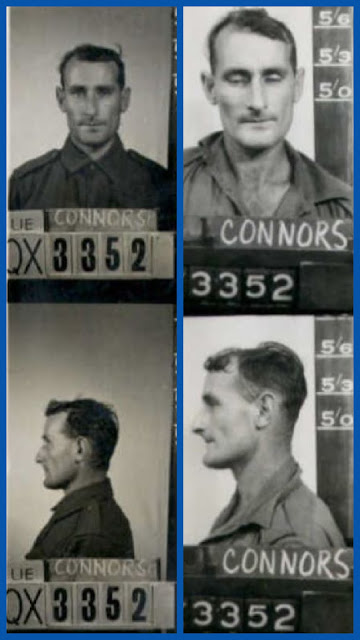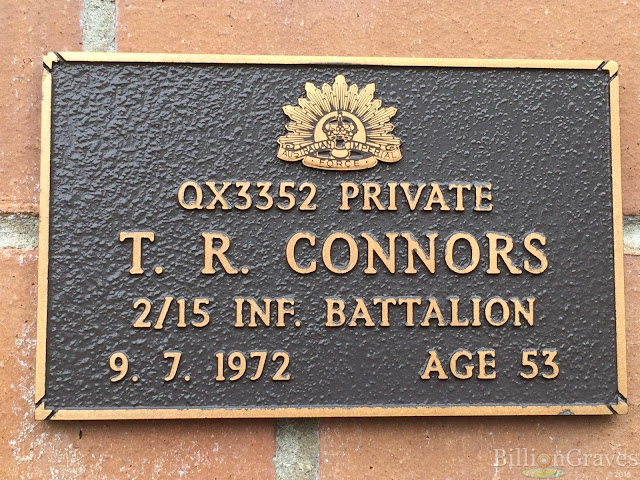In Remembrance
(For my 'Family Anniversaries' page)
Today is the anniversary of the passing of my maternal Great Grand Uncle, Patrick Joseph Farrell.
*Our common ancestors are: Michael Farrell and Susan Muldowney/Downey.
- Patrick was born on the 11th of April 1877, at 56 Havannah Street in a mining village named Tanfield, near Stanley in County Durham, England.
- When Patrick was born his father, Michael Farrell, was 42 and his mother, Susan Muldowney / Downey, was 35.
- Patrick was the 7th of nine children born to Michael and Susan, who were both Irish-born but had moved to Scotland and then England in search of work.
- At the age of 3, Patrick was listed on the 1881 England Census as living at 140 Havanna Street in the civil parish of Tanfield, in the district of Lanchester, County Durham, England. This would have one house in a long row of colliery houses provided by the mine owners.
- His father Michael was working as a 'coke drawer'. His older brother Thomas, aged 13, was working at the colliery as a 'screener'. His older sister Margaret (my great grandmother), aged 15, was not living with the family as she was employed as a servant for the Robinson family in a house at 10 Havanna Street. Patrick's other siblings included Helen Ann aged 9, Elizabeth aged 7, Michael aged 5, and his 8 month old brother James.
- Life for Patrick in his early childhood years would have been one of poverty and deprivation. These early years were spent in the Durham coalfield region of north-east England where his father worked primarily as a 'coke drawer'. The family moved around the region a fair bit, from Lanchester to Tanfield to Stanley, looking for lodging and living in mining village housing. These colliery houses were usually overcrowded, lacking adequate sanitation and basic amenities like running water. The family would have experienced impoverished living conditions, starvation at times and likely poor health.
- In 1887 another brother, Matthew Felix, was born when Patrick was 9 years old.
- Shortly after, Patrick's family boarded the ship Cheybassa and headed to Australia. At the time, Patrick's older sisters Margaret and Helen had already emigrated and were living in Queensland. The remainder of the Farrell family, including Patrick joined them.
- In September of 1887 the Farrell family disembarked in Townsville, north Queensland, and then travelled on to Charters Towers. Patrick was 10 years old.
- Patrick followed in his father's footsteps at first, and began working as a miner in his early adult years.
- The Australian Electoral Rolls for the years 1903 and 1908, when he was aged 26 and 31 respectively, show that Patrick was living at a place named 'Bluff Station', just outside Charters Towers, and his occupation was listed as 'miner'.
- Patrick was also learning another trade during these years. At some point, he had become apprenticed to his brother-in-law, David Davies, as an iron moulder.
- Around 1911, Patrick had left Charters Towers and moved to Maryborough where he started work as an iron moulder for Walkers Limited.
- He was known as "Joe" to his friends at this time.
- When he lived in Maryborough, he was an active member of the local community and earned a reputations as a "skilful and willing worker" with "many friends".
 |
| Attestation Papers - signed by Patrick in 1916 |
- On the 17th of November 1916, aged 39, Patrick enlisted for service in World War 1 in Bundaberg, Queensland. He enlisted with the AIF 25th Battalion 19th Reinforcement.
- His signature gives us a hint that Patrick had not written much in his lifetime up to that point and while he was able to write a signature, it was not written smoothly and expertly. Given that Patrick was 39 years old, I was a little taken aback by rather childish-looking attempt.
- Patrick was the oldest of three Farrell brothers who felt the need to do their duty for the British Empire and answered the call to serve with the Australian Forces.
- His younger brother James had enlisted in January of 1916, and his youngest brother Matthew had enlisted in July of 1916. Perhaps Patrick felt the need to follow suit out of guilt or concern about his brothers going off to war without him. Whatever the reason, Patrick enlisted before the end of 1916.
- After enlistment, Patrick joined the reinforcements of the 25th Battalion for training at Enoggera camp in Brisbane, Queensland.
 |
| Copyright expired - image in public domain |
- After three months of training, Patrick's unit embarked from Sydney on board HMAT A18 Wiltshire on the 7th of February 1917, and headed off to war.
- Patrick disembarked at Plymouth, in England on the 11th of April 1917, and marched into the 7th Training Battalion's camp in Rollestone that same day where he prepared for service on the Western Front.
- Once that training was completed, he proceeded overseas to France on the 30th of July 1917 and was admitted to the 2nd Australian Divisional Base Depot the next day.
- After two weeks at Base Depot, Patrick marched out to join the 25th Battalion in billets outside Saint-Omer in northern France.
- The 25th remained outside Saint-Omer, training and resting, until the 12th of September, when they moved to Winnipeg Camp outside Steenvoorde on the Franco-Belgian border.
- On the 17th of September, the battalion moved forward into Belgium, taking over the front line outside Westhoek the next day. They readied themselves to take part in the next big attack of the Allied offensive aimed at capturing Passchendaele.
- Early on the morning of the 20th of September, the men of A Company of the 25th Battalion, including Patrick, were behind their jumping off tape in the trenches. They were waiting for the signal to launch the attack on their objectives around Zonnebeke Ridge and along the Menin Road.
- Just after 5.40 am, as the men were beginning to leave the trenches, Patrick received a direct hit in the head from an enemy shell, known among the soldiers as a whizz bang.
- Sadly, Patrick was killed in action within two months of disembarkation. He died instantly on the 20th of September 1917 near Polygon Wood in Belgium. He was aged 40.
- There are specific details recorded in the Australian Red Cross Society's Wounded and Missing Enquiry files, some a little more gruesome than the one I've added above. Thankfully, Patrick's death was instantaneous and he would not have suffered.
- Although a note in Patrick's service record stated that his remains were buried after his death, his grave could not be located after the end of the war. He is commemorated on the Menin Gate Memorial, alongside the names of over 6,000 Australians who served in the Ypres Campaign and have no known grave.
- Death notices for Patrick were published in newspapers in both Charters Towers and Maryborough. It was noted in one of the items that Patrick's brothers James and Matthew were both away overseas, fighting at the front. Thankfully, both returned home safely.
- Patrick's name appears on the Ypres-Menin Gate Memorial in Belgium, inscribed on Panel 23, and the Australian War Memorial in Canberra, Australia on Panel 104.








































































